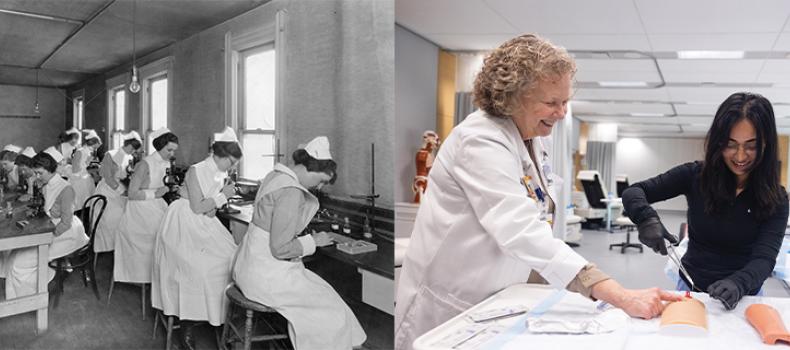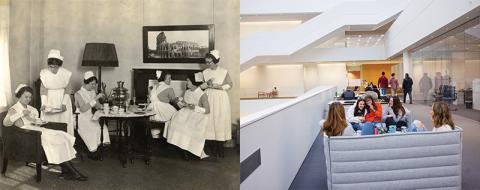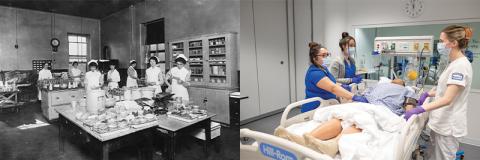If Frances Payne Bolton were to walk through the halls of her namesake school today, she would find students from around the world, drawn to study in top-ranked programs taught by internationally recognized faculty conducting research that continues to push the field forward.
“We’ve never settled for being an average school,” said Carol Musil, PhD, RN (NUR ’79; GRS ’91, nursing), dean of Frances Payne Bolton School of Nursing at Case Western Reserve University.
One hundred years ago, when Bolton made a transformative gift to establish the School of Nursing, nurses were educated much differently. Most programs were hospital-based and focused on teaching and clinical education—not on scholarship, research or driving change in healthcare.
In providing the resources for a stand-alone university-based nursing school rooted in systematic inquiry and rigor, Bolton ignited an entirely new approach to nursing practice and education.
“The growth and evolution of our school has driven changes in the entire profession,” said Musil, also the Edward J. and Louise Mellen Professor of Nursing. “I think Mrs. Bolton would be pleased to know our graduates and faculty have shaped and improved care wherever they go—which is pretty much everywhere across the globe.”
Pushing the profession forward
Though the roots of the School of Nursing can be traced back to the establishment of the Lakeside Hospital Training School in Cleveland in 1898, the birth of the modern institution can be attributed to Bolton’s generous donation of $500,000 in stocks in 1923, which was then the largest gift ever made to a university school of nursing.
The endowment elevated nursing from a department to its own college within Western Reserve University, making it one of the first of its kind in the country.
At the time, Bolton’s gift was considered unconventional and speculative—even for a Standard Oil heiress who was then one of the richest women in the world. After all, she never attended college herself.
What Bolton did possess was an intense interest and appreciation for the nursing profession, which started as a teenager volunteering for the local chapter of the Visiting Nurses Association, a charity caring for the poor.
In the years ahead, Bolton’s influence—and support for the nursing field—only expanded.
Bolton ran her first successful bid to the U.S. House in 1940. As a U.S. congresswoman, she was forthright and effective—addressing the nursing shortage during World War II by securing passage of the Bolton Act in 1943, during her second term. The law created the U.S. Cadet Nurse Corps, which provided training and education for more than 125,000 nurses in the program’s first year alone. Many continued into the profession after the war.
Thanks to Bolton, the program’s funding was distributed without discrimination based on race or ethnicity—a then-controversial stipulation that she insisted on, arguing it was rooted in fairness and fundamental to the spirit of the nursing profession.
Like many pioneers, Bolton was considered ahead of her time—setting an example that resonates today and continues to inform the inclusive nature of the School
of Nursing.
Leading the way
As a condition of Bolton’s gift, the School of Nursing had to adopt an experimental approach. It’s proven to be a hallmark of the institution.
Innovation in scholarship and education at the nursing school—including the creation of degree programs that were among the first in the world and now widely adopted—have pushed the field forward and helped establish nursing as a distinct discipline of its own.
“Mrs. Bolton wanted nurses to have the same opportunity for a stellar education that was available to other health professionals,” said Joyce Fitzpatrick, PhD (MGT ’92), Distinguished University Professor and former dean. “She was a visionary and helped put the field on that new path.”
From the beginning of the newly independent School of Nursing, standards—and ambitions—have been set high.
In launching the country’s first Master of Nursing degree in 1934, the school adopted strict criteria—requiring students to possess a degree from an accredited institution to enroll. Dean Marion Howell (FSM 1920) faced heavy criticism, especially given enrollment challenges brought on by the Great Depression and an ongoing nursing shortage. Nevertheless, Howell remained steadfast in her commitment to raising academic standards, and, three years later, the school awarded the first nursing graduate degrees in U.S. history.
A short time later, the Bolton Act swelled enrollment at the school and severely stretched facilities and faculty resources. While standards for admission were temporarily lowered for the war effort, Dean Helen Bunge established the New Basic Program in 1947, which reinstituted high-level requirements in coursework and for admission—setting the stage for the school’s ascendence in the following decades.
Driving discovery
Mid-century, in many circles, nursing was still not considered its own field in healthcare.
“By the late 1960s, there was movement toward nursing becoming a discipline,” Ronald Hickman Jr., PhD (CWR ’00; NUR ’02 ’06, ’13; GRS ’08, nursing), associate dean for research in the Center for Research and Scholarship, which has operated the school’s research infrastructure since 1990.
“In order to become a discipline within a university setting,” he added, “you have to have a fundamental body of knowledge produced by scholars.”
Early scholarship at the nursing school emphasized the role of the relationship between nurse and patient, which influenced education. Nurse training began to focus on consideration of the patient’s emotional wellbeing as well as physical health. Dean Elizabeth Porter believed close supervision by faculty who were also active researchers helped students develop an understanding of the complexities of nursing in clinical settings.
In the 1960s, the increasing complexity of healthcare systems and a shortage of healthcare personnel prompted a formal transformation of nursing education. Dean Rozella Schlotfeldt, PhD (HON ‘96), and her successor, Janetta MacPhail, PhD, spearheaded a groundbreaking “Experiment in Nursing” program that established clear principles in nurse educational training by adapting clinical training models from medical schools.
Both deans also recruited nationally, inviting nursing scientists—often trained in other health fields—to join the faculty to foster a research-oriented culture that stressed publishing and involvement in professional organizations.
“The development of new knowledge directly improved patient care and elevated nursing in higher education and in healthcare,” said professor emerita and former dean May Wykle, PhD (NUR ’62, ’69; GRS ’81, education), a faculty member since 1969. “Doors were starting to open for nurses to have many pathways of practice.”
In the 1970s, MacPhail oversaw the launch of the third PhD program in the country at the nursing school and, by decade’s end, the introduction of the Nursing Doctorate (ND), the first of its kind in the U.S.
Defining the future
In 1982, Fitzpatrick was named dean—and a new era began. During her 15-year tenure as dean, fundraising surged, “which allowed us to do more creative things,” she said, “and put us on the cutting edge in new programs and research, which also served to generate additional resources.”
By the late ’90s, the school’s endowment surpassed $40 million and eight endowed professorships had been established—the most at any U.S. nursing school at the time.
Fitzpatrick also spearheaded the effort to offer opportunities in advanced clinical nursing practice, establishing the Doctor of Nursing Practice (DNP) degree, “which was the first in the country and the world,” said Fitzpatrick, the Elizabeth Brooks Ford Professor of Nursing. “Now it’s a standard program in hundreds of nursing schools.”
Funding for research was also becoming more abundant, especially from the precursor to the National Institute of Nursing Research, established in 1986 at the National Institutes of Health (NIH).
“It wasn’t that long ago,” said Hickman, who is also the Ruth M. Anderson Professor. “But we were well positioned to immediately become leaders.”
Today, the nursing school has six Centers of Excellence—including the University Center on Aging and Health and the Dorothy Ebersbach Academic Center for Flight Nursing—in top-notch facilities at the Health Education Campus of Case Western Reserve and Cleveland Clinic. The building’s 2019 opening marked a significant milestone in the effort to create a collaborative and integrated approach to health sciences education, with Case Western Reserve’s nursing, dental and medical schools, including its Cleveland Clinic Lerner College of Medicine, calling the nearly 477,000-square-foot building home.
Offering opportunity for all
Nursing is one of the most practiced professions worldwide, with 27 million men and women accounting for almost half of the global health workforce, according to the World Health Organization.
But the diversity of the profession was not always reflected in the student body at the School of Nursing.
“In our class pictures over the years, you can start to see our students reflect the composition of the communities we serve, more and more,” said Wykle, who became the first Black dean of the School of Nursing in 2001 and served a decade in the post. “Mrs. Bolton was pleased to see the school becoming more diverse.”
In the House of Representatives, Bolton led influential efforts to make nursing more inclusive—targeting discrimination against male nurses and people of color and by providing opportunities for qualifying students with financial aid.
She was also instrumental in the passage of the Civil Rights Acts of 1957, 1960, 1964 and 1968, as well as the Voting Rights Act of 1965—and served as a trustee at the Tuskegee Institute, a historically Black land-grant university.
“Mrs. Bolton set a tone with her beliefs, and her actions have reverberated through the school,” said Camille Beckette Warner, PhD (GRS ’97, ’02, sociology), associate dean of diversity, equity and inclusion and an assistant professor.
In 1954, Betty Smith Williams (NUR ‘58) successfully challenged her initial rejection from the School of Nursing and became its first Black student awarded a Master of Nursing degree. She later established the National Association of Black Nurses in 1971 and served on the nursing faculty of the University of California at Los Angeles.
“Our students and graduates have made history,” said Warner. “But our work to improve equity and equality in our profession continues—racially, economically, spiritually, religiously and through gender inclusivity.”
That includes growing international efforts—whether increasing enrollment of international students, teaching or conducting research abroad, or partnering on educational and public health initiatives.
“We’ve demonstrated a dedication to international outreach and provided a global influence almost from the beginning—and undoubtedly in our contemporary work,” said Mary Quinn Griffin, PhD, RN (NUR ’93; GRS ’01, nursing), professor and institutional researcher.
Recently, immersive study abroad experiences have also been introduced, in which undergraduates travel together to observe nursing practices in the face of pressing issues, such as the health effects of climate change—further demonstrating the nursing school’s commitment to tackling challenges beyond borders.
Looking back—and forward
Audrey Palmer (CWR ‘23) graduated from the nursing school this spring.
Ever since nurses helped her recover from a childhood surgery, she’s wanted to be in healthcare. The southern California native chose the School of Nursing for its emphasis on clinical placements—starting within a student’s first month on campus—with large healthcare institutions, including University Hospitals and Cleveland Clinic.
Throughout her four years as an undergraduate, Palmer had more than 1,500 hours of direct care experience; now, she wants to start her career in a pediatric intensive care unit and eventually become a nurse anesthetist.
“Coming here has helped me focus my dream to help others,” said Palmer. “Professors are willing to challenge you as much as you’re willing to accept that challenge—and it drives everyone to be the best nurse they can be.”
Palmer’s experience, and those of her classmates, shows how the institution is still striving to realize the ideals envisioned by its founder.
“I think Frances Payne Bolton would be quite proud to see where we are today,” said Musil, “and even prouder to know her vision is guiding us in our mission to improve nursing and health outcomes for all.”
This article was published in the Summer 2023 issue of Forefront Magazine. To view the digital issue and other stories, visit https://case.edu/nursing/news-events/forefront-magazine.






